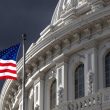by Liz Ann Sonders, Kathy Jones, Jeffrey Kleintop, Charles Schwab & Company Ltd.
The big question, of course, is whether the Federal Reserve and other central banks will find a way to subdue inflation without causing a recession. As with the weather, though, the signs are frustratingly muddled. Corporate earnings, for example, have weakened, while other evidence suggests global manufacturing activity is actually strengthening. At the same time, longer-term Treasury yields have risen as the Fed has signaled it's not done raising interest rates just yet.
The absence of clarity can be unsettling. Here's how we see things shaping up.
U.S. stocks and economy: Mixed signals
Median wage growth has remained "sticky" even as average hourly earnings declined
Source: Charles Schwab, Bloomberg, as of 1/31/2023.
Atlanta Fed's Wage Growth Tracker is a measure of the nominal wage growth of individuals.
Any further tightening in policy might compound pressure building from a weaker corporate earnings backdrop. The share of companies in the S&P 500® Index reporting quarterly earnings above analysts' average estimates—known as the "beat rate"—has fallen in the reporting season for the fourth quarter of 2022. Not only that, but the companies that have beat estimates are doing so by the smallest margins since the 2007-2008 financial crisis.
Corporate earnings are not beating expectations as much as they used to

Source: Charles Schwab, I/B/E/S data from Refinitiv, as of 4Q2022.
Right y-axis truncated for visual purposes. Past performance is no guarantee of future results.
Fixed income: Is the bond bear back?
The Fed's messaging combined with stronger-than-expected labor market data have renewed concerns that a bond bear market, with falling prices and rising yields, may be coming. We don't think that's likely. Here's why:
1. The Fed has allowed the yield curve to remain inverted, with longer-term yields below short-term yields. In past cycles, intermediate- and long-term bond yields have tended to stay low or keep falling until the Fed is near the end of its rate-hiking cycle—and bottom out at the onset of recession. Each recession is different, but the historical pattern has been consistent.
Where does that leave us now? Estimates of the terminal rate for interest rates are rising, while the Fed's rate hikes continue to push the yield curve to more steeply inverted levels. As a result, an inverted yield curve is likely to be a key feature of the Treasury market in 2023.
The two-year/10-year Treasury yield curve is inverted

Source: Bloomberg, daily data as of 2/13/2023.
Market Matrix US Sell 2 Year & Buy 10 Year Bond Yield Spread (USCY2Y10 INDEX). The rates are composed of Market Matrix U.S. Generic spread rates (USYC2Y10). This spread is a calculated Bloomberg yield spread that replicates selling the current 2 year U.S. Treasury Note and buying the current 10 year U.S. Treasury Note, then factoring the differences by 100. Gray bars represent recessions. Past performance is no guarantee of future results.
2. Inflation has been declining, and inflation expectations are moderate. The Fed has recently indicated concern that inflation in the service sector (excluding housing) is stubbornly high. However, weakening consumer spending suggests price growth will continue to slow.
Inflation appears to have peaked

Source: U.S. Consumer Price Index Topline Contributions. Monthly data as of 1/31/2023.
Headline inflation reflects price changes to a basket of goods that includes commodities like food and energy. Core inflation excludes food and energy, whose prices tend to be volatile.
Personal consumption spending has slowed

Source: Bloomberg. Monthly data as of 12/31/2022.
US Personal Consumption Expenditures Chained 2012 Dollars MoM SA. (PCE CHNC Index).
Consumers expect inflation of less than 3% over the next five-10 years

Source: Bloomberg. Monthly data as of 2/28/2023.
Forecasts contained herein are for illustrative purposes only, may be based upon proprietary research and are developed through analysis of historical public data. University of Michigan 1-year inflation expectations (CONSEXP Index) and 5-10 year inflation expectations (CONSP5MD Index).
Lending standards have tightened since 2021

Source: Federal Reserve, January 2023.
Senior Loan Officer Opinion Survey on Bank Lending Practices, January 2023. Net percentage of domestic respondents tightening standards for commercial and industrial loans.
Consumer credit growth has slowed

Source: Federal Reserve, monthly data as of 12/31/2022.
Consumer Credit Total Net Monthly Change (CICTOT Index).
Global stocks and economy: Green shoots?
Global manufacturing has lagged in the post-pandemic era as inventory shortages turned to gluts last year, even as global demand for services (like travel and entertainment) boomed. In fact, according to purchasing managers' index (PMI) surveys of manufacturing business leaders, global exports of manufactured goods, and revenues of manufacturing firms, factory output actually fell into a recession at the end of last summer.
Now, however, signs have started to emerge that manufacturing may be bouncing back as surplus inventories are drawn down. Indeed, activity in leading industrial-driven economies like China and Germany is picking up, with the China PMI and German Ifo Business Climate Index both having recovered from lows reached in September-October 2022. Globally, manufacturing output is still weak, but forward-looking expectations and components such as new-orders-to-inventory ratios may be signaling the start of a rebound.
Based on new-orders-to-inventory ratios, manufacturing may be poised to rebound

Source: Charles Schwab, S&P Global, Bloomberg data as of 2/9/2023.
The tradeoff, of course, is that such a recovery could prevent central banks from the enacting the interest rate cuts that the market seems to expect later this year. After forecasting further hikes for the first half of this year (see the orange columns in the chart below), the futures market has priced in rate cuts beginning in the second half of the year (blue columns) for many of the major central banks.
Market sees hikes in first half of the year, then cuts in second half

Source: Charles Schwab, Bloomberg data as of 2/9/2023.
The chart reflects the futures market implied rate in each country or region. A basis point is one-hundredth of a percentage point, or 0.01%.
If economic green shoots do take root, stocks that tend to benefit from rate cuts, such as growth stocks, could suffer, while cyclical value stocks may fare better.
Kevin Gordon, Senior Investment Strategist, contributed to this report.















